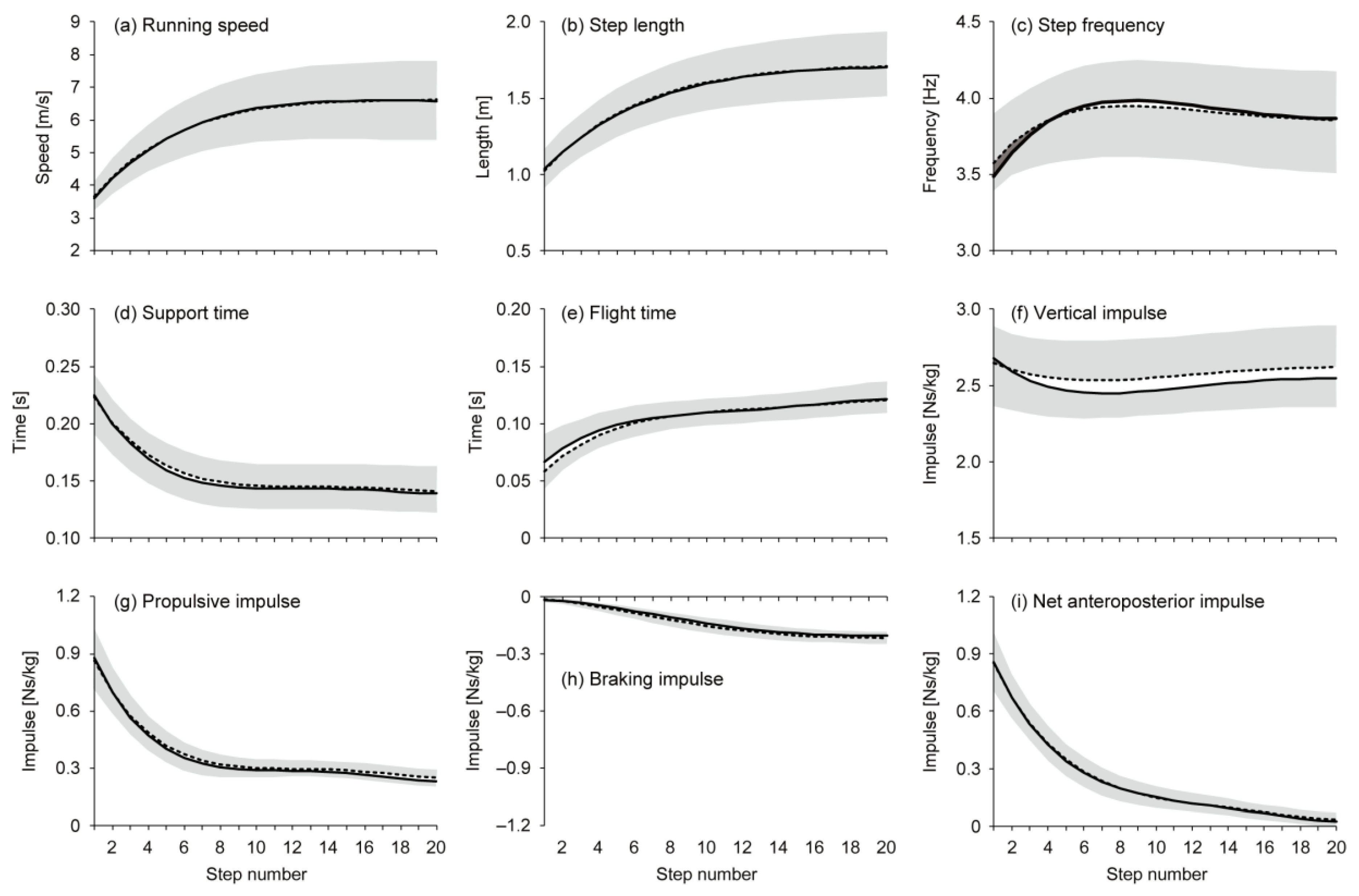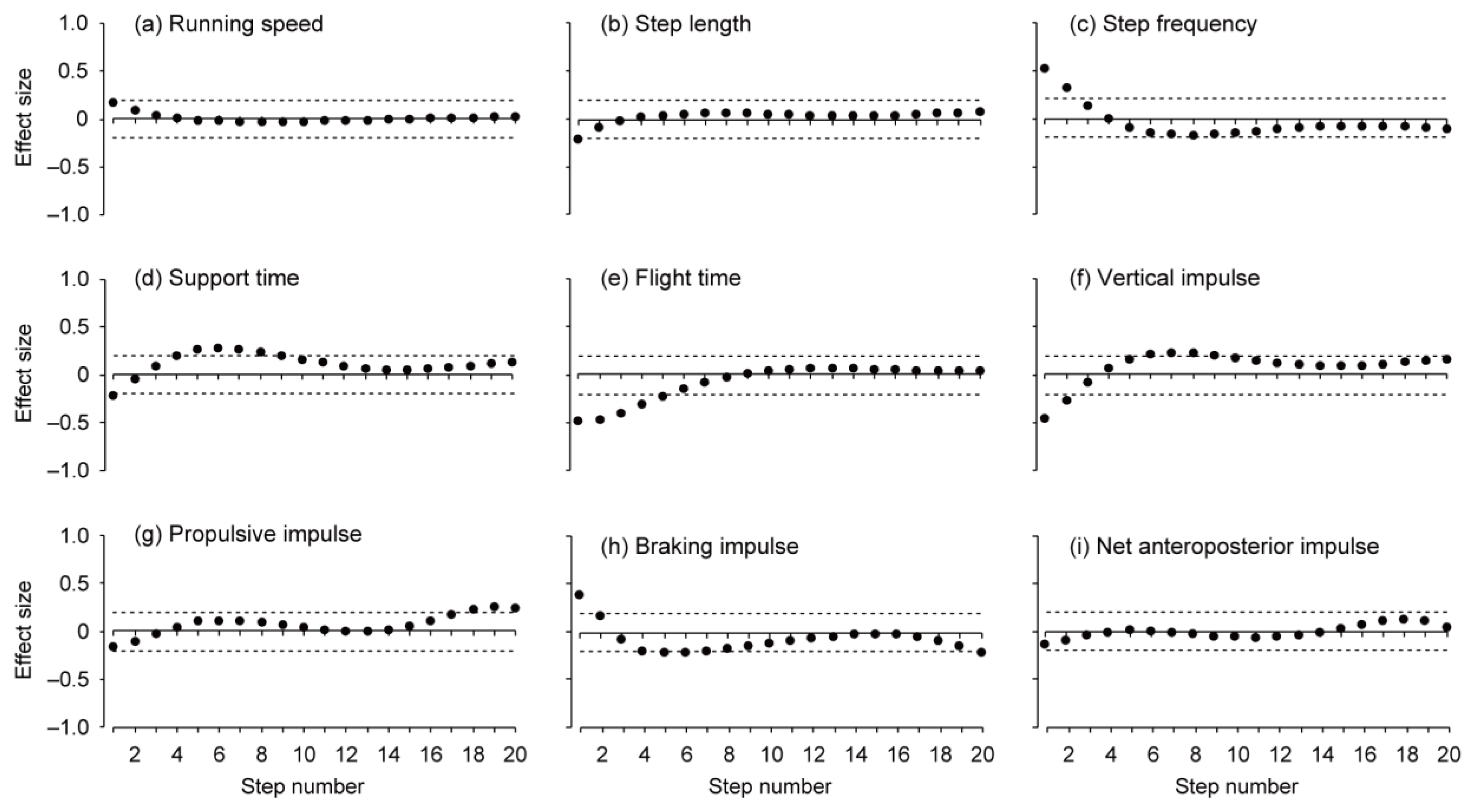Influence of the Intention to Lean the Body Forward on Kinematics and Kinetics of Sprinting for Active Adults
Abstract
:1. Introduction
2. Materials and Methods
2.1. Participants
2.2. Experiments
2.3. Data Processing
2.4. Statistical Analyses
3. Results
4. Discussion
5. Conclusions
Author Contributions
Funding
Acknowledgments
Conflicts of Interest
References
- Slawinski, J.; Termoz, N.; Rabita, G.; Guilhem, G.; Dorel, S.; Morin, J.B.; Samozino, P. How 100-m event analyses improve our understanding of world-class men’s and women’s sprint performance. Scand. J. Med. Sci. Sports 2017, 27, 45–54. [Google Scholar] [CrossRef] [PubMed]
- Nagahara, R.; Naito, H.; Miyashiro, K.; Morin, J.B.; Zushi, K. Traditional and ankle-specific vertical jumps as strength-power indicators for maximal sprint acceleration. J. Sports Med. Phys. Fitness 2014, 54, 691–699. [Google Scholar] [PubMed]
- Nagahara, R.; Naito, H.; Morin, J.B.; Zushi, K. Association of acceleration with spatiotemporal variables in maximal sprinting. Int. J. Sports Med. 2014, 35, 755–761. [Google Scholar] [CrossRef] [PubMed]
- Nagahara, R.; Mizutani, M.; Matsuo, A.; Kanehisa, H.; Fukunaga, T. Association of step width with accelerated sprinting performance and ground reaction force. Int. J. Sports Med. 2017, 38, 534–540. [Google Scholar] [CrossRef] [PubMed]
- Nagahara, R.; Matsubayashi, T.; Matsuo, A.; Zushi, K. Kinematics of the thorax and pelvis during accelerated sprinting. J. Sports Med. Phys. Fitness 2018, 58, 1253–1263. [Google Scholar] [PubMed]
- Nagahara, R.; Mizutani, M.; Matsuo, A.; Kanehisa, H.; Fukunaga, T. Association of sprint performance with ground reaction forces during acceleration and maximal speed phases in a single sprint. J. Appl. Biomech. 2018, 34, 104–110. [Google Scholar] [CrossRef]
- Nagahara, R.; Mizutani, M.; Matsuo, A.; Kanehisa, H.; Fukunaga, T. Step-to-step spatiotemporal variables and ground reaction forces of intra-individual fastest sprinting in a single session. J. Sports Sci. 2018, 36, 1392–1401. [Google Scholar] [CrossRef]
- Rabita, G.; Dorel, S.; Slawinski, J.; Saez-de-Villarreal, E.; Couturier, A.; Samozino, P.; Morin, J.B. Sprint mechanics in world-class athletes: a new insight into the limits of human locomotion. Scand. J. Med. Sci. Sports 2015, 25, 583–594. [Google Scholar] [CrossRef] [PubMed]
- Kugler, F.; Janshen, L. Body position determines propulsive forces in accelerated running. J. Biomech. 2010, 43, 343–348. [Google Scholar] [CrossRef] [PubMed]
- Colyer, S.L.; Nagahara, R.; Salo, A.I.T. Kinetic demands of sprinting shift across the acceleration phase: Novel analysis of entire force waveforms. Scand. J. Med. Sci. Sports 2018, 28, 1784–1792. [Google Scholar] [CrossRef] [PubMed]
- Kawamori, N.; Nosaka, K.; Newton, R.U. Relationships between ground reaction impulse and sprint acceleration performance in team sport athletes. J. Strength Cond. Res. 2013, 27, 568–573. [Google Scholar] [CrossRef] [PubMed]
- Morin, J.B.; Edouard, P.; Samozino, P. Technical ability of force application as a determinant factor of sprint performance. Med. Sci. Sports Exerc. 2011, 43, 1680–1688. [Google Scholar] [CrossRef] [PubMed]
- Bezodis, N.E.; North, J.S.; Razavet, J.L. Alterations to the orientation of the ground reaction force vector affect sprint acceleration performance in team sports athletes. J. Sports Sci. 2017, 35, 1817–1824. [Google Scholar] [CrossRef] [PubMed]
- Bezodis, N.E.; Trewartha, G.; Salo, A.I. Understanding the effect of touchdown distance and ankle joint kinematics on sprint acceleration performance through computer simulation. Sports Biomech. 2015, 14, 232–245. [Google Scholar] [CrossRef] [PubMed]
- Caekenberghe, I.V.; Segers, V.; Aerts, P.; Willems, P.; De Clercq, D. Joint kinematics and kinetics of overground accelerated running versus running on an accelerated treadmill. J. R Soc. Interface 2013, 10, 20130222. [Google Scholar] [CrossRef] [PubMed] [Green Version]
- Cohen, J. Statistical Power Analysis for the Behavioral Sciences, 2nd ed.; Lawrence Earlbaum Associates: Hillsdale, NJ, USA, 1988. [Google Scholar]
- Hopkins, W.G. How to interpret changes in an athletic performance test. Sportscience 2004, 8, 1–7. [Google Scholar]
- Winter, E.M.; Abt, G.A.; Nevill, A.M. Metrics of meaningfulness as opposed to sleights of significance. J. Sports Sci. 2014, 32, 901–902. [Google Scholar] [CrossRef] [PubMed]
- Bencsik, L.; Zelei, A. Effects of human running cadence and experimental validation of the bouncing ball model. Mech. Syst. Sign. Proc. 2016, 89, 78–87. [Google Scholar] [CrossRef]
- Hunter, J.P.; Marshall, R.N.; McNair, P.J. Relationships between ground reaction force impulse and kinematics of sprint-running acceleration. J. Appl. Biomech. 2005, 21, 31–43. [Google Scholar] [CrossRef] [PubMed]


© 2019 by the authors. Licensee MDPI, Basel, Switzerland. This article is an open access article distributed under the terms and conditions of the Creative Commons Attribution (CC BY) license (http://creativecommons.org/licenses/by/4.0/).
Share and Cite
Nagahara, R.; Amini, E.; Marcon, K.C.C.; Chen, P.-W.; Chua, J.; Eiberger, J.; Futalan, N.J.C.; Lye, J.; Pantovic, M.M.; Starczewski, M.; et al. Influence of the Intention to Lean the Body Forward on Kinematics and Kinetics of Sprinting for Active Adults. Sports 2019, 7, 133. https://doi.org/10.3390/sports7060133
Nagahara R, Amini E, Marcon KCC, Chen P-W, Chua J, Eiberger J, Futalan NJC, Lye J, Pantovic MM, Starczewski M, et al. Influence of the Intention to Lean the Body Forward on Kinematics and Kinetics of Sprinting for Active Adults. Sports. 2019; 7(6):133. https://doi.org/10.3390/sports7060133
Chicago/Turabian StyleNagahara, Ryu, Elaheh Amini, Kelly Cristina Cesco Marcon, Peng-Wen Chen, Jessica Chua, Jens Eiberger, Nathaniel Jonathan Claridad Futalan, Jamie Lye, Marko Milan Pantovic, Michal Starczewski, and et al. 2019. "Influence of the Intention to Lean the Body Forward on Kinematics and Kinetics of Sprinting for Active Adults" Sports 7, no. 6: 133. https://doi.org/10.3390/sports7060133
APA StyleNagahara, R., Amini, E., Marcon, K. C. C., Chen, P.-W., Chua, J., Eiberger, J., Futalan, N. J. C., Lye, J., Pantovic, M. M., Starczewski, M., Sudsa-ard, K., Sumartiningsih, S., Wang, C.-Y., William, T. B., Kasujja, T., & Gujar, T. A. (2019). Influence of the Intention to Lean the Body Forward on Kinematics and Kinetics of Sprinting for Active Adults. Sports, 7(6), 133. https://doi.org/10.3390/sports7060133




